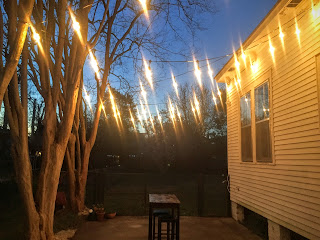Since everyone's space varies, I'll just show you a handful of tools and tricks to help you get the desired effect with little cost and big payoff-- all in an afternoon and for under $150!
- Use as much of your natural environment as you can! You can add anchor points to fences, trees, your house, etc. , just make sure all surfaces are protected from weather. If they move in wind, make sure you have enough slack in your line and on your anchor points.
- Get commercial-grade outdoor lights like these suspended base ones from 1000Bulbs based in Texas. They are industrial, built for outdoors, and the suspended base helps take load away from the wire string itself. The 1000Bulbs website also has great options for the bulbs themselves, of course.
- If affixing anchor points to trees, use plastic-coated wire and soft tubing to not damage your plants. We bought a garden soaker hose to cut into lengths, and it was really cheap.
- Create your own wire loops with cable ferrules that can be crimped around the ends. You can use these to attach around trees, fence posts, etc, without damaging the surfaces. They can be unclipped very easily if you need to remove or replace your lights. These loops with tubing in between is what we used to secure the lights to our trees.
- Quick Links or even S-Clips create clean attachment to your anchor points without stressing either the anchor or your lighted wire. Make sure the links you purchase can fit around your wire or eyelets you may use!
- If using an outdoor outlet or electrical extension, protect the light outlet from weather by covering thoroughly in waterproof electrical tape or encapsulating the join with an all-weather extension cover made for Christmas lights. It's imperative to keep all electrical terminals away from the elements, even when unplugged to resist corrosion.
- Lastly, be sure to measure, measure, measure again before cutting, installing any anchor points, or even buying the light string. Use trigonometry to calculate how much lighted footage you'll need, inclusive of the swagging in between points!


No comments:
Post a Comment